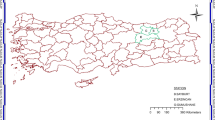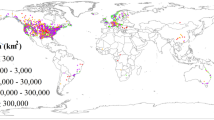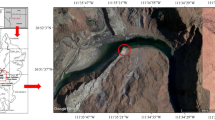Abstract
Streamflow prediction is an important matter for the water resources management and the design of hydraulic structures that can be built on rivers. Recently, it has become a widely studied research field where data obtained from stream gauge stations can be utilized for creating estimating models by resorting to different methods such as machine and deep learning techniques. In this study, we performed monthly streamflow predictions by using the following data-driven methods of machine learning: linear regression, support vector regression, random forest and deep learning (DL) models to compare the performances of ML's and DL's techniques. A general workflow that can be applied to similar regions is presented. An estimating model containing six-input combinations and time-lagged streamflow data is improved by means of the autocorrelation function (ACF) and partial autocorrelation function (PACF). Furthermore, moving average is used as a smoothing technique to make the dataset more stable and reduce the effects of noise data. A comparative evaluation has been conducted to determine the performances of the above-mentioned methods. In this study, we proposed four different DL models and compared them with existing techniques. For the comparison of the results, we used evaluation criteria such as Nash–Sutcliffe efficiency (NSE), mean square error (MSE) and percent bias (PBIAS). The experimental results indicate that our bidirectional gated recurrent units (BiGRU) model outperforms both ML algorithms and existing solutions with 0.971 NSE, 0.001 MSE and − 1.536 PBIAS scores.



















Similar content being viewed by others
Availability of Data and Materials
The datasets generated during and/or analyzed during the current study are available from the corresponding author on reasonable request.
References
Abd Jalil NA, Ahmad MH, Mohamed N (2013) Electricity load demand forecasting using exponential smoothing methods. World Appl Sci J 22(11):1540–1543
Abda Z, Zerouali B, Chettih M, Santos CAG, De Farias CAS, Elbeltagi A (2022) Assessing machine learning models for streamflow estimation: a case study in Oued Sebaou watershed (Northern Algeria). Hydrol Sci J 67(9):1328–1341. https://doi.org/10.1080/02626667.2022.2083511
Abdollahi S, Raeisi J, Khalilianpour M, Ahmadi F, Kisi O (2017) Daily mean streamflow prediction in perennial and non-perennial rivers using four data driven techniques. Water Resour Manag 31(15):4855–4874. https://doi.org/10.1007/s11269-017-1782-7
Adnan RM, Liang Z, Heddam S, Zounemat-Kermani M, Kisi O, Li B (2020) Least square support vector machine and multivariate adaptive regression splines for streamflow prediction in mountainous basin using hydro-meteorological data as inputs. J Hydrol 586:124371. https://doi.org/10.1016/j.jhydrol.2019.124371
Aghelpour P, Bahrami-Pichaghchi H, Varshavian V (2021) Hydrological drought forecasting using multi-scalar streamflow drought index, stochastic models and machine learning approaches, in Northern Iran. Stoch Env Res Risk Assess. https://doi.org/10.1007/s00477-020-01949-z
Aimran AN, Afthanorhan A (2014) A comparison between single exponential smoothing (SES), double exponential smoothing (DES), holt’s (Brown) and adaptive response rate exponential smoothing (ARRES) techniques in forecasting Malaysia population. Glob J Math Anal 2(4):276
Almikaeel W, Čubanová L, Šoltész A (2022) Hydrological drought forecasting using machine learning—Gidra river case study. Water 14(3):387. https://doi.org/10.3390/w14030387
Altın TB, Sarış F, Altın BN (2019) Determination of drought intensity in Seyhan and Ceyhan river basins, Turkey, by hydrological drought analysis. Theoret Appl Climatol 139(1–2):95–107. https://doi.org/10.1007/s00704-019-02957-y
Apaydin H, Feizi H, Sattari MT, Colak MS, Shamshirband S, Chau K (2020) Comparative analysis of recurrent neural network architectures for reservoir inflow forecasting. Water 12(5):1500. https://doi.org/10.3390/w12051500
Apaydin H, Taghi Sattari M, Falsafian K, Prasad R (2021) Artificial intelligence modelling integrated with singular spectral analysis and seasonal-trend decomposition using loess approaches for streamflow predictions. J Hydrol 600:126506. https://doi.org/10.1016/j.jhydrol.2021.126506
Aziz Sharfuddin A, Nafis Tihami M, Saiful Islam M (2018) A deep recurrent neural network with BiLSTM model for sentiment classification. In: 2018 ınternational conference on bangla speech and language processing (ICBSLP). https://doi.org/10.1109/icbslp.2018.8554396
Bayer Altin T, Altin BN (2021) Response of hydrological drought to meteorological drought in the eastern Mediterranean Basin of Turkey. J Arid Land 13(5):470–486. https://doi.org/10.1007/s40333-021-0064-7
Box GE, Jenkins GM, Reinsel GC, Ljung GM (2015) Time series analysis: forecasting and control. Wiley, Hoboken
Breiman L (2001) Random forests. Mach Learn 45(1):5–32
Chae J, Thom D, Bosch H, Jang Y, Maciejewski R, Ebert DS, Ertl T (2012) Spatiotemporal social media analytics for abnormal event detection and examination using seasonal-trend decomposition. In: 2012 IEEE conference on visual analytics science and technology (VAST). https://doi.org/10.1109/vast.2012.6400557
Chen W, Cheng L, Chang Z, Wen B, Li P (2022) Wind turbine blade ıcing detection using a novel bidirectional GRU with temporal pattern attention and ımproved coot optimization algorithm. Meas Sci Technol
Cheng M, Fang F, Kinouchi T, Navon I, Pain C (2020) Long lead-time daily and monthly streamflow forecasting using machine learning methods. J Hydrol 590:125376. https://doi.org/10.1016/j.jhydrol.2020.125376
Chiang Y, Hao R, Zhang J, Lin Y, Tsai W (2018) Identifying the sensitivity of ensemble streamflow prediction by artificial intelligence. Water 10(10):1341. https://doi.org/10.3390/w10101341
Cho K, Kim Y (2022) Improving streamflow prediction in the WRF-hydro model with LSTM networks. J Hydrol 605:127297. https://doi.org/10.1016/j.jhydrol.2021.127297
Cho K, Van Merriënboer B, Gulcehre C, Bahdanau D, Bougares F, Schwenk H, Bengio Y (2014) Learning phrase representations using RNN encoder-decoder for statistical machine translation. arXiv:1406.1078.
Clay (2021). Graphical ıntroduction note about GRU—Clay-technology world. Retrieved September 24, 2022. from https://clay-atlas.com/us/blog/2021/07/27/gru-en-introduction-note/
Cleveland WS (1979) Robust locally weighted regression and smoothing Scatterplots. J Am Stat Assoc 74(368):829–836. https://doi.org/10.1080/01621459.1979.10481038
Cleveland WS, Devlin SJ (1988) Locally weighted regression: an approach to regression analysis by local Fitting. J Am Stat Assoc 83(403):596–610. https://doi.org/10.1080/01621459.1988.10478639
Cleveland RB, Cleveland WS, McRae JE, Terpenning I (1990) STL: a seasonal-trend decomposition. J Off Stat 6(1):3–73
Danandeh Mehr A, Kahya E, Bagheri F, Deliktas E (2013) Successive-station monthly streamflow prediction using neuro-wavelet technique. Earth Sci Inf 7(4):217–229. https://doi.org/10.1007/s12145-013-0141-3
Dokumentov A, Hyndman RJ (2021) STR: seasonal-trend decomposition using regression. Informs J Data Sci. https://doi.org/10.1287/ijds.2021.0004
DSI (2011) The General Directorate State Hydraulic Works (2011). Streamflow observation annuals. https://www.dsi.gov.tr/Sayfa/Detay/744 (Access date: 01.02.2022)
EIEI- General Directorate of Electric Power Resources Survey and Development Administration (1940–2011). Streamflow observation annuals. https://www.dsi.gov.tr/Sayfa/Detay/744 (Access date: 01.02.2022)
Essam Y, Huang YF, Ng JL, Birima AH, Ahmed AN, El-Shafie A (2022) Predicting streamflow in Peninsular Malaysia using support vector machine and deep learning algorithms. Sci Rep 12:3883. https://doi.org/10.1038/s41598-022-07693-4
Fan J, Gijbels I (2018) Applications of local polynomial modelling. Local Polynomial Modell Appl. https://doi.org/10.1201/9780203748725-5
Fu M, Fan T, Ding Z et al (2020) Deep learning data-intelligence model based on adjusted forecasting window scale: application in daily streamflow simulation. IEEE Access 8:32632–32651
Gers FA, Schraudolph NN, Schmidhuber J (2002) Learning precise timing with LSTM recurrent networks. J Mach Learn Res 3(Aug):115–143
Gumus V (2019) Spatio-temporal precipitation and temperature trend analysis of the Seyhan-Ceyhan river basins, Turkey. Meteorol Appl 26(3):369–384. https://doi.org/10.1002/met.1768
Gümüş V, Kavşut ME (2013) Zamanti nehri-ergenusaği istasyonu eksik aylik akim verilerinin tahmini. Gazi Univ J Sci Part c Des Technol 1(2):81–91
Hadi SJ, Tombul M (2018) Forecasting daily streamflow for basins with different physical characteristics through data-driven methods. Water Resour Manag 32(10):3405–3422
Hagan MT, Behr SM (1987) The time series approach to short term load forecasting. IEEE Trans Power Syst 2(3):785–791. https://doi.org/10.1109/tpwrs.1987.4335210
Hagen JS, Leblois E, Lawrence D, Solomatine D, Sorteberg A (2021) Identifying major drivers of daily streamflow from large-scale atmospheric circulation with machine learning. J Hydrol 596:126086. https://doi.org/10.1016/j.jhydrol.2021.126086
Hanoon MS, Abdullatif AAB, Ahmed AN, Razzaq A, Birima AH, El-Shafie A (2021) A comparison of various machine learning approaches performance for prediction suspended sediment load of river systems: a case study in Malaysia. Earth Sci Inform 15(1):91–104. https://doi.org/10.1007/s12145-021-00689-0
Härdle W, Vieu P (1992) Kernel regression smoothing of time series. J Time Ser Anal 13(3):209–232. https://doi.org/10.1111/j.1467-9892.1992.tb00103.x
Hassan M, Shamim MA, Hashmi HN, Ashiq SZ, Ahmed I, Pasha GA, Naeem UA, Ghumman AR, Han D (2014) Predicting streamflows to a multipurpose reservoir using artificial neural networks and regression techniques. Earth Sci Inf 8(2):337–352. https://doi.org/10.1007/s12145-014-0161-7
Hochreiter S (1998) The vanishing gradient problem during learning recurrent neural nets and problem solutions. Int J Uncertain Fuzziness Knowl Based Syst 6(02):107–116
Hochreiter S, Schmidhuber J (1997) Long short-term memory. Neural Comput 9(8):1735–1780
Hu C, Wu Q, Li H, Jian S, Li N, Lou Z (2018) Deep learning with a long short-term memory networks approach for rainfall-runoff simulation. Water 10(11):1543. https://doi.org/10.3390/w10111543
Hussain D, Khan AA (2020) Machine learning techniques for monthly river flow forecasting of Hunza river, Pakistan. Earth Sci Inform 13(3):939–949. https://doi.org/10.1007/s12145-020-00450-z
Hussain D, Hussain T, Khan AA, Naqvi SA, Jamil A (2020) A deep learning approach for hydrological time-series prediction: a case study of Gilgit river basin. Earth Sci Inf 13(3):915–927. https://doi.org/10.1007/s12145-020-00477-2
Karasu S, Altan A (2019). Recognition model for solar radiation time series based on random forest with feature selection approach. İn: 2019 11th ınternational conference on electrical and electronics engineering (ELECO). https://doi.org/10.23919/eleco47770.2019.8990664
Kaya YZ, Zelenakova M, Üneş F, Demirci M, Hlavata H, Mesaros P (2021) Estimation of daily evapotranspiration in Košice city (Slovakia) using several soft computing techniques. Theoret Appl Climatol 144(1–2):287–298. https://doi.org/10.1007/s00704-021-03525-z
Keras Team. (2022). Keras documentation: earlystopping. https://keras.io/api/callbacks/early_stopping/
Khazaee Poul A, Shourian M, Ebrahimi H (2019) A comparative study of MLR, KNN, ANN and ANFIS models with wavelet transform in monthly stream flow prediction. Water Resour Manag 33:2907–2923. https://doi.org/10.1007/s11269-019-02273-0
Khosravi K, Golkarian A, Tiefenbacher JP (2022) Using optimized deep learning to predict daily streamflow: a comparison to common machine learning algorithms. Water Resour Manag 36(2):699–716. https://doi.org/10.1007/s11269-021-03051-7
Kilinc HC, Haznedar B (2022) A hybrid model for streamflow forecasting in the Basin of Euphrates. Water 14(1):80. https://doi.org/10.3390/w14010080
Kim T, Cho S (2019) Predicting residential energy consumption using CNN-LSTM neural networks. Energy 182:72–81. https://doi.org/10.1016/j.energy.2019.05.230
Kuan CH, Leu Y, Lin WS, Lee CP (2022) The estimation of the long-term agricultural output with a robust machine learning prediction model. Agriculture 12(8):1075. https://doi.org/10.3390/agriculture12081075
Lafare AE, Peach DW, Hughes AG (2016) Use of seasonal trend decomposition to understand groundwater behaviour in the Permo-Triassic Sandstone aquifer, Eden Valley, UK. Hydrogeol J 24(1):141–158
Latif SD, Ahmed AN, Sathiamurthy E, Huang YF, El-Shafie A (2021) Evaluation of deep learning algorithm for inflow forecasting: A case study of durian Tunggal reservoir, peninsular Malaysia. Nat Hazards 109(1):351–369. https://doi.org/10.1007/s11069-021-04839-x
Le XH, Ho HV, Lee G, Jung S (2019) Application of long short-term memory (LSTM) neural network for flood forecasting. Water 11(7):1387. https://doi.org/10.3390/w11071387
Le XH, Nguyen DH, Jung S, Yeon M, Lee G (2021) Comparison of deep learning techniques for river streamflow forecasting. IEEE Access 9:71805–71820. https://doi.org/10.1109/ACCESS.2021.3077703
Li X, Sha J, Wang Z (2019) Comparison of daily streamflow forecasts using extreme learning machines and the random forest method. Hydrol Sci J 64(15):1857–1866. https://doi.org/10.1080/02626667.2019.1680846
Lin Y, Wang D, Wang G, Qiu J, Long K, Du Y, Xie H, Wei Z, Shangguan W, Dai Y (2021) A hybrid deep learning algorithm and its application to streamflow prediction. J Hydrol 601:126636. https://doi.org/10.1016/j.jhydrol.2021.126636
Lu C, Lee T, Chiu C (2009) Financial time series forecasting using independent component analysis and support vector regression. Decis Support Syst 47(2):115–125. https://doi.org/10.1016/j.dss.2009.02.001
Mehdizadeh S, Fathian F, Adamowski JF (2019) Hybrid artificial intelligence-time series models for monthly streamflow modeling. Appl Soft Comput 80:873–887. https://doi.org/10.1016/j.asoc.2019.03.046
Meshram SG, Meshram C, Santos CA, Benzougagh B, Khedher KM (2021) Streamflow prediction based on artificial intelligence techniques. Iran J Sci Technol Trans Civ Eng. https://doi.org/10.1007/s40996-021-00696-7
Momani PN (2009) Time series analysis model for rainfall data in Jordan: case study for using time series analysis. Am J Environ Sci 5(5):599–604. https://doi.org/10.3844/ajessp.2009.599.604
Niu W, Feng Z (2021) Evaluating the performances of several artificial intelligence methods in forecasting daily streamflow time series for sustainable water resources management. Sustain Cities Soc 64:102562. https://doi.org/10.1016/j.scs.2020.102562
Ozkaya A, Zerberg Y (2021) Water storage change assessment in the Seyhan reservoir (Turkey) using HEC-ressim model. Arab J Geosci. https://doi.org/10.1007/s12517-021-06882-1
Pektaş AO, Cigizoglu HK (2013) ANN hybrid model versus ARIMA and ARIMAX models of runoff coefficient. J Hydrol 500:21–36
Provost F, Kolluri V (1999) A survey of methods for scaling up inductive algorithms. Data Min Knowl Disc 3(2):131–169
Qiu X, Zhang L, Nagaratnam Suganthan P, Amaratunga GA (2017) Oblique random forest ensemble via least square estimation for time series forecasting. Inf Sci 420:249–262. https://doi.org/10.1016/j.ins.2017.08.060
Rahimzad M, Moghaddam Nia A, Zolfonoon H, Soltani J, Danandeh Mehr A, Kwon H (2021) Performance comparison of an LSTM-based deep learning model versus conventional machine learning algorithms for streamflow forecasting. Water Resour Manag 35(12):4167–4187. https://doi.org/10.1007/s11269-021-02937-w
Saggi MK, Jain S, Bhatia AS, Sharda R (2022) Proposition of new ensemble data-intelligence model for evapotranspiration process simulation. J Ambient Intell Humaniz Comput. https://doi.org/10.1007/s12652-021-03636-5
Saka AT (2021, January 28) Long short term memory (LSTM) model in stock prediction. Medium. https://abdullahsaka.medium.com/long-short-term-memory-lstm-model-in-stock-prediction-d0e1c93717b3
Sammen SS, Ehteram M, Abba SI, Abdulkadir RA, Ahmed AN, El-Shafie A (2021) A new soft computing model for daily streamflow forecasting. Stoch Env Res Risk Assess 35(12):2479–2491. https://doi.org/10.1007/s00477-021-02012-1
Schoppa L, Disse M, Bachmair S (2020) Evaluating the performance of random forest for large-scale flood discharge simulation. J Hydrol 590:125531. https://doi.org/10.1016/j.jhydrol.2020.125531
Selek B, Tuncok IK (2013) Effects of climate change on surface water management of Seyhan basin, Turkey. Environ Ecol Stat 21(3):391–409. https://doi.org/10.1007/s10651-013-0260-5
Selvin S, Vinayakumar R, Gopalakrishnan EA, Menon VK, Soman KP (2017) Stock price prediction using LSTM, RNN and CNN-sliding window model. In: 2017 ınternational conference on advances in computing, communications and ınformatics (ICACCI). https://doi.org/10.1109/icacci.2017.8126078
Shahid F, Zameer A, Muneeb M (2020) Predictions for COVID-19 with deep learning models of LSTM, GRU and Bi-LSTM. Chaos Solitons Fractals 140:110212. https://doi.org/10.1016/j.chaos.2020.110212
Shu X, Ding W, Peng Y et al (2021) Monthly streamflow forecasting using convolutional neural network. Water Resour Manag 35(15):5089–5104
Sklearn.preprocessing.MinMaxScaler (2022) scikit-learn. Retrieved April 1, 2022. from https://scikit-learn.org/stable/modules/generated/sklearn.preprocessing.MinMaxScaler
Srivastava N, Hinton G, Krizhevsky A, Sutskever I, Salakhutdinov R (2014) Dropout: a simple way to prevent neural networks from overfitting. J Mach Learn Res 15(1):1929–1958
Turhan E (2021) A comparative evaluation of the use of artificial neural networks for modeling the rainfall–runoff relationship in water resources management. J Ecol Eng 22(5):166–178. https://doi.org/10.12911/22998993/135775
Turhan E, Keleş MK, Tantekin A, Keleş AE (2019) The investigation of the applicability of data-driven techniques in hydrological modeling: the case of seyhan basin. Rocz Ochr Śr 21
Van SP, Le HM, Thanh DV, Dang TD, Loc HH, Anh DT (2020) Deep learning convolutional neural network in rainfall–runoff modelling. J Hydroinf 22(3):541–561. https://doi.org/10.2166/hydro.2020.095
Verbesselt J, Hyndman R, Newnham G, Culvenor D (2010) Detecting trend and seasonal changes in satellite image time series. Remote Sens Environ 114(1):106–115. https://doi.org/10.1016/j.rse.2009.08.014
Verikas A, Vaiciukynas E, Gelzinis A, Parker J, Olsson MC (2016) Electromyographic patterns during golf swing: activation sequence profiling and prediction of shot effectiveness. Sensors 16(4):592
Wang Z, Wang Y, Zeng R, Srinivasan RS, Ahrentzen S (2018) Random forest based hourly building energy prediction. Energy Build 171:11–25. https://doi.org/10.1016/j.enbuild.2018.04.008
Wen Q, Gao J, Song X, Sun L, Xu H, Zhu S (2019) RobustSTL: a robust seasonal-trend decomposition algorithm for long time series. Proc AAAI Conf Artif Intell 33:5409–5416. https://doi.org/10.1609/aaai.v33i01.33015409
Wu C, Ho J, Lee D (2004) Travel-time prediction with support vector regression. IEEE Trans Intell Transp Syst 5(4):276–281. https://doi.org/10.1109/tits.2004.837813
Xiang Z, Demir I (2020) Distributed long-term hourly streamflow predictions using deep learning—a case study for state of Iowa. Environ Modell Softw 131:104761. https://doi.org/10.1016/j.envsoft.2020.104761
Yaghoubi B, Hosseini SA, Nazif S (2019) Monthly prediction of streamflow using data-driven models. J Earth Syst Sci. https://doi.org/10.1007/s12040-019-1170-1
Yaseen ZM, El-shafie A, Jaafar O, Afan HA, Sayl KN (2015) Artificial intelligence based models for stream-flow forecasting: 2000–2015. J Hydrol 530:829–844. https://doi.org/10.1016/j.jhydrol.2015.10.038
Yaseen ZM, Jaafar O, Deo RC, Kisi O, Adamowski J, Quilty J, El-Shafie A (2016) Stream-flow forecasting using extreme learning machines: a case study in a semi-arid region in Iraq. J Hydrol 542:603–614. https://doi.org/10.1016/j.jhydrol.2016.09.035
Yin H, Jin D, Gu YH, Park CJ, Han SK, Yoo SJ (2020) STL-ATTLSTM: vegetable price forecasting using STL and attention mechanism-based LSTM. Agriculture 10(12):612. https://doi.org/10.3390/agriculture10120612
Young C, Liu W, Wu M (2017) A physically based and machine learning hybrid approach for accurate rainfall-runoff modeling during extreme typhoon events. Appl Soft Comput 53:205–216. https://doi.org/10.1016/j.asoc.2016.12.052
Zhang Y, Wang Q, Chen X, Yan Y, Yang R, Liu Z, Fu J (2022) The prediction of spark-ignition engine performance and emissions based on the SVR algorithm. Processes 10(2):312
Zhu S, Zhou J, Ye L, Meng C (2016) Streamflow estimation by support vector machine coupled with different methods of time series decomposition in the upper reaches of Yangtze River, China. Environ Earth Sci. https://doi.org/10.1007/s12665-016-5337-7
Zou KH, Tuncali K, Silverman SG (2003) Correlation and simple linear regression. Radiology 227(3):617–628. https://doi.org/10.1148/radiol.2273011499
Funding
The authors declare that no funds, grants or other support were received during the preparation of this manuscript.
Author information
Authors and Affiliations
Contributions
All authors contributed to the study conception and design. Material preparation, data collection and analysis were performed by ÖA, DFK, MKK and ET. The first draft of the manuscript was written by all authors. All authors read and approved the final manuscript.
Corresponding author
Ethics declarations
Conflict of interest
The authors declare that they have no relevant known competing financial or non-financial interests to disclose, or personal relationships that could have appeared to influence the work reported in this paper.
Ethical approval
Authors certify that the submission is original work and is not published at any other publications. Also, authors declare that this article does not contain any studies with human participants or animals performed by any authors.
Consent to participate
Authors state that all the contributing authors are actively participated in this research study. Also authors consent to their participation in the entire review process.
Consent to publish
Authors have agreed to submit the article in this journal and have allowed publication if the research is accepted. Also authors wish to publish the research findings.
Additional information
Edited by Prof. Jarosław Napiórkowski (ASSOCIATE EDITOR) / Dr. Michael Nones (CO-EDITOR-IN-CHIEF).
Rights and permissions
Springer Nature or its licensor (e.g. a society or other partner) holds exclusive rights to this article under a publishing agreement with the author(s) or other rightsholder(s); author self-archiving of the accepted manuscript version of this article is solely governed by the terms of such publishing agreement and applicable law.
About this article
Cite this article
Ayana, Ö., Kanbak, D., Kaya Keleş, M. et al. Monthly streamflow prediction and performance comparison of machine learning and deep learning methods. Acta Geophys. 71, 2905–2922 (2023). https://doi.org/10.1007/s11600-023-01023-6
Received:
Accepted:
Published:
Issue Date:
DOI: https://doi.org/10.1007/s11600-023-01023-6




